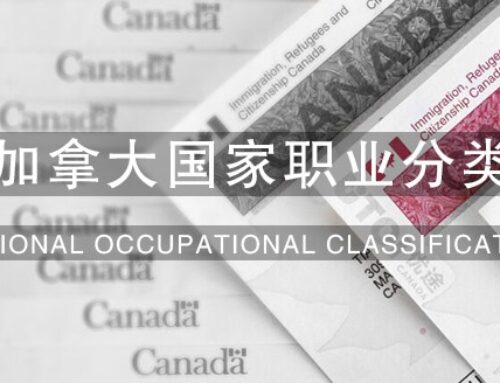加拿大国家职业分类 TEER NOC Code(NOC-TEER)
加拿大国家职业分类(NOC)是对加拿大现存所有职业,进行系统化分类的标准,为加拿大劳动力市场上的每个职业分配了代码和工作描述。也是移民部在审核加拿大移民的申请人职业类别时,作为参考的唯一依据。
The National Occupation Classification (NOC) is a nationally recognized and standardized system that assigns a code and job description to every occupation in the Canadian labour market.
国家职业分类2021版-TEER分类标准 New NOC 2021- TEER Categories
自2022年11月16日起,国家职业分类系统逐步废弃之前使用的2016版本,并开始启用当前正在使用的2021版。此次升级,着重将之前2016版本强调的「技能分类」转换成当前2021版强调的「TEER分类」。2022年11月16日之后递交的所有申请都将以国家职业分类2021版为准。申请人可以使用加拿大政府提供的线上工具,确认自己的NOC分类。四个字母意为:Training 培训、 Education 教育、 Experience 经验以及 Responsibilities责任,这四大标准将重新定义职业要求,也能更精准划分申请类别。
As of November 16th, 2022, the NOC system made the switch from the previous NOC 2016 to the new current NOC 2021. Among other changes, the NOC 2021 system switched from skill type to TEER categories. All new applications filed after November 16th, will need to use the correct NOC 2021. You can use the tool provided by the Canadian government to check what your TEER NOC 2021 is.
国家职业分类代码解读 Understanding NOC Codes
申请人在递交移民申请时,选择正确的国家职业分类代码至关重要。如果申请时使用的代码与申请人的工作经验不符,申请可能会被退回,甚至直接导致被拒。申请人需要确保选择正确的代码并提供足够的支持文件。每个职业分类代码,都有对应的职称、岗位引言描述,以及主要职责罗列。
从加拿大移民角度而言,在决定使用哪个职业分类代码时,申请人在现实生活中的实际岗位职称并不重要。相反,申请人的工作经验必须与岗位引言描述相符,并在日常工作中履行该职业分类代码所罗列出的大部分主要职责。因此,申请人的工作经历,可能分别对应着几个不同的国家职业代码;或者,现实生活中的岗位职称所关联的职业分类代码,与申请人的工作经历完全不相符。
加拿大国家职业分类以「培训、教育、经验和责任,即TEER」为标准对职业进行划分。自TEER0至TEER5共有六种分类,代码中的第二位数代表着TEER类别。代码分解如下:
- 第一位数字,代表广义职业类别;
- 第二位数字,代表TEER类别;
- 前两位数字叠加,代表主要组别;
- 前三位数字叠加,代表次要组别;
- 前四位数字叠加,代表小类组别;
- 完整的五位数字叠加,代表职业本身。
Choosing the right NOC code is one of the most important parts of your immigration application. If you claim a NOC code that doesn’t actually match your work experience, your application may be refused or returned to you. It’s up to you to make sure that you choose the appropriate NOC code and that you have the documentation to prove it. Every NOC code has an associated job title, lead statement, and list of major duties and responsibilities.
For Canadian immigration purposes, your actual job title is not important in determining your NOC code. Instead, your work experience has to match the lead statement, and you should have performed most of the duties and responsibilities listed. Your work experience might therefore fall under a couple of different NOC codes, or your official job title might be associated with a NOC code that doesn’t actually match your experience.
The NOC organizes occupations by assigning them a Training, Education, Experience and Responsibilities (TEER) category. There are six different TEER categories ranging from TEER 0 to TEER 5. The second digit of your NOC code indicates your TEER category. NOC codes are broken down as follows:
- The first digit represents the broad occupational category;
- The second digit represents the TEER category;
- The first two digits together represent the major group;
- The first three digits represent the sub-major group;
- The first four digits represent the minor group; and finally
- The full five digits represent the unit group or the occupation itself.
广义职业领域 (代码中第一位数)Broad Occupation Category (BOC, the first digit of NOC Code)
| 0 | 立法机关或高层管理岗位 | Legislative and senior management occupations |
| 包括立法者和高级管理人员。 | This broad occupational category contains legislators and senior management occupations. | |
| 1 | 工商、金融、行政岗位 | Business, finance and administration occupations |
| 包括与提供金融和商业服务、行政和监管服务以及文书监督和支持服务有关的职业。在这个广泛的职业类别中,有些职业是金融和商业服务部门所独有的;但大多数都存在于所有行业。 | This broad occupational category contains occupations that are concerned with providing financial and business services, administrative and regulatory services, and clerical supervision and support services. Some occupations in this broad occupational category are unique to the financial and business service sectors; however, most are found in all industries. | |
| 2 | 自然或应用科学领域相关岗位 | Natural and applied sciences and related occupations |
| 包含科学领域的专业和技术职业,包括物理和生命科学、工程、建筑和信息技术。 | This broad occupational category contains professional and technical occupations in the sciences, including physical and life sciences, engineering, architecture, and information technology. | |
| 3 | 健康卫生领域相关岗位 | Health occupations |
| 包括直接向病患提供保健服务的职业,和向专业医疗人员提供支持性的辅助职业。 | This broad occupational category includes occupations concerned with providing health care services directly to patients and occupations that provide support to professional and technical health care staff. | |
| 4 | 教育、社会与法律、社工及政府服务部门相关岗位 | Occupations in education, law and social, community and government services |
| 包括与教学、法律、社会和社区服务、社会科学、公共管理(包括前线公共保护服务)、制定政府政策、管理政府和其他项目有关的职业。 | This broad occupational category includes occupations that are concerned with teaching, law, social and community services, social sciences, occupations in public administration (including front line public protection services), developing government policy, and administering governmental and other programs. | |
| 5 | 艺术、文化、运动领域相关岗位 | Occupations in art, culture, recreation and sport |
| 包括与艺术和文化相关的专业和技术职业,包括表演艺术、电影和录像、广播、新闻、写作、创意设计、图书馆和博物馆。它还包括娱乐和体育方面的职业。 | This broad occupational category includes professional and technical occupations related to art and culture, including the performing arts, film and video, broadcasting, journalism, writing, creative design, libraries, and museums. It also includes occupations in recreation and sport. | |
| 6 | 销售及服务行业相关岗位 | Sales and service occupations |
| 包括销售职业以及个人和客户服务职业,包括酒店和旅游业。 | This broad occupational category contains sales occupations as well as personal and customer service occupations, including hospitality and tourism. | |
| 7 | 技工、设备操作员、运输业相关岗位 | Trades, transport and equipment operators and related occupations |
| 包括销售职业以及个人和客户服务职业,包括酒店和旅游业。这个广泛的职业类别包括建筑和机械行业,行业主管和承包商,以及运输和重型设备的操作员。这些职业存在于广泛的行业中。 | This broad occupational category includes construction and mechanical trades, trades supervisors and contractors, and operators of transportation and heavy equipment. These occupations are found in a wide range of industries. | |
| 8 | 自然资源、农业及相关岗位 | Natural resources, agriculture and related production occupations |
| 包括采矿、石油和天然气生产、林业和伐木、农业、园艺、渔业、狩猎和诱捕等以自然资源为基础的部门的监督和设备操作职业。这一类别中的大多数职业都属于特定行业,不会出现在相关产业之外。
这一宽泛的职业类别还包括大多数学徒制行业。这一类别的其他职业通常需要完成大学或其他课程,并结合在职培训。随着经验的积累,可能晋升为主管或自雇承包商。由于大多数职业都有特定的学徒制、培训和执照要求,这类职业之间的技能流动性或可转移性有限。 |
This broad occupational category contains supervisory and equipment operation occupations in the natural resource-based sectors of mining, oil and gas production, forestry and logging, agriculture, horticulture, fishing, hunting, and trapping. Most occupations in this category are industry specific and do not occur outside of the primary industries.
This broad occupational category also includes most of the apprentice-able trades. Other occupations in this category usually require completion of college or other programs combined with on-the-job training. Progression to supervisory or self-employed contractor status is possible with experience. There is limited mobility or transferability of skills among occupations in this category due to specific apprenticeship, training, and licensing requirements for most occupations. |
|
| 9 | 制造业及公共设施产业相关岗位 | Occupations in manufacturing and utilities |
| 包括制造业、加工业和公用事业领域的监督和生产职业。 | This broad occupational category contains supervisory and production occupations in manufacturing, processing, and utilities. |
TEER等级类别(代码中第二位数)TEERs (the second digit of NOC Code)
| TEER 0 |
|
|
| TEER 1 |
|
|
| TEER 2 |
|
|
| TEER 3 |
|
|
| TEER 4 |
|
|
| TEER 5 |
|
|
高技能与低技能岗位 High-Skilled and Low-Skilled Work
出于移民目的,任何被归类于TEER 0/1/2/3级别的职业都被认为是高技能岗位;任何归类于TEER 4/5级别的职业被认为是低技能岗位。如需确认申请人所从事的工作是否被纳入TEER分类,最简单的方式是查看加拿大就业和社会发展部官网上的国家职业分类矩阵。一般而言,国家职业分类代码遵循以下规律:
代码第一位数字,代表广义职业类别。共有0至9十种技能类型,代表广义的工作领域。例如,技能类型2包括所有“自然和应用科学,以及所有相关职业”。
代码第二位数字,代表TEER等级类别。代码的第二个数字与TEER等级相关联,共有五个等级。例如,当代码第二位数为0时,TEER等级为0;第二位数为1时,TEER等级为1。
For immigration purposes, any occupation classified as TEER level 0,1,2 or 3 is considered high-skilled work. Any occupation classified as TEER level 4 or 5 is considered low-skilled work. The easiest way to tell whether your occupation is classified is to check the NOC Matrix on the Employment and Social Development Canada (ESDC) website. However, NOC codes mostly follow a formula:
The first digit in a NOC code identifies the broad occupational category. There are ten Skill Types (0 to 9) that refer to broad areas of work. For example, Skill Type 2 includes all ‘Natural and applied sciences and related occupations.
The second digit in a NOC code identifies the TEER. There are five Skill Levels, and each one is associated with the second digit of the NOC code for instance: where the second digit is 0, the TEER skill level is 0. Where the second digit is 1, the TEER skill level is 1 and so on.
主要组别与次要组别 Major and Minor Groups
政府发布的移民项目指南,有时会涉及主要及次要组别:
主要组别是指国家职业分类代码的前两位数字叠加。例如,主要组别31涉及的卫健领域大多数职业(技能类型3)中,通常需要从业人员在大学中接受教育(技能类型A)。所有上述岗位都将被分配一个以数字31开头的国家职业分类代码。其中包括牙医(3113)、药剂师(3131)和营养师(3132)。
次要组别是指国家职业分类代码的前三位数字叠加。将每个主要组别中的类似职业加以细分并再归类。例如,法官(4111)和律师(4112)都属于次要组别411;社工(4152)与家庭顾问(4153)都属于次要组别415。值得注意的是,每个次要组别的前两位数叠加代表其所属的主要组别。在上述例子中,社工和家庭顾问都属于主要组别41。
Sometimes, immigration program guides might refer to NOC Major or Minor Groups:
Major Groups refer to the first two digits of a NOC code together. For example, Major Group 31 refers to most occupations in the health industry (Skill Type 3) that generally require university education (Skill Level A). All of these occupations will be assigned a NOC code that begins with the numbers 31. This includes dentists (3113), pharmacists (3131), and nutritionists (3132), among others.
Minor Groups refer to the first three digits or a NOC code. They group together similar occupations within each major group. For example, judges (4111) and lawyers (4112) are both in Minor Group 411. Social workers (4152) and family counsellors (4153) are both in Minor Group 415. Notice that the first two digits of each minor group refer to the major group it belongs to. In this example, Major Group 41.
国家职业分类代码查询 Finding Your NOC Code
申请人可以通过浏览行业或输入关键词(如职位)搜索国家职业分类矩阵找到对应的国家职业分类代码。申请人一定要确认其工作经验与岗位引言描述相符,并且在日常工作中履行该职业分类代码所罗列出的大部分主要职责。
同时,也要密切关注国家职业分类代码中的「排除项」。如果申请人的职业似乎与某个特定的代码相匹配,但又与该代码中罗列出的「排除项」吻合,则申请人不能使用该代码。无论申请人使用哪个国家职业分类代码,都需要前雇主的雇主信来证明其准确性。如果申请人的职业似乎与多个代码匹配,则需选择其中最准确的那个。需要注意的是,移民官对国家职业分类矩阵有着深入的了解。如果他们认为申请人采用的代码不合适,申请可能遭拒。点击搜索国家职业分类矩阵
You can find your NOC code by searching the NOC matrix either by your industry, or by keywords such as your job title. Be sure to check that the lead statement matches your job description, and that you perform the majority of the duties and responsibilities listed under the NOC code.
Pay close attention to the NOC exclusions also. If your occupation seems to match a certain NOC code, but also matches one of the NOC codes listed as an exclusion, you may not claim that occupation. Whichever NOC code you claim, you will need to prove that it is accurate by providing reference letters from your past employers. In the event that your occupations seem to match multiple NOC codes, you must determine which one best fits your experience. Keep in mind that the visa officer reviewing your application will have in-depth knowledge of the NOC matrix. If they determine that your occupations best fit a different NOC code, they may refuse your application. Search the NOC Matrix






